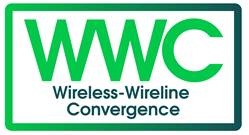Active WWC Projects
WT/MD/SD# | 5G PS | Abstract | Related Contributions | Editor(s) |
|---|---|---|---|---|
AGF Functional Requirements | Issue 3 of the AGF Specification | Contributions | ||
AGF CUPS | Wireless and Wireline Convergence with Control and User Plane Separation - Reference Architecture, Interface, and Protocol Specification | Contributions | ||
| WT-470i3 | 5G Wireless Wireline Convergence Architecture | 5G Wireless Wireline Convergence Architecture Issue 3 | Contributions |
WT/MD/SD# | Multi-Tenant FWA Projects | Abstract | Related Contributions | Editor(s) |
|---|---|---|---|---|
WT-507 | Key Issues on FWA Extension | FWA solution for delivery inside a MDU/MTU | ||
MD-TBD | Benefit of Multi-Tenant FWA | TBA |
WT/MD/SD# | WWC Marketing | Abstract | Related Contributions | Editor(s) |
|---|---|---|---|---|
MD-470 | Value of WWC | FWA solution for delivery inside a MDU/MTU | ||
MD-506 | 5G Hybrid / ATSSS | TBA |
Completed WWC Projects
WT/MD/SD# 5G PS Abstract Related Contributions Editor(s) 5G Wireless Wireline Convergence Architecture The scope of this working text is to describe the functional requirements of the Access Gateway Function (AGF). The AGF resides in between the aggregation network of fixed access nodes such as OLTs or DSLAMs, the V-interface (specified by BBF TR-178) and the 5G Core network (specified by 3GPP). It serves both FN-RG as well as 5G-RG. WT/MD/SD# IMS for 5G-RG PS Abstract Related Contributions Editor(s) WT/MD/SD# Hybrid Access Projects Abstract Related Contributions Editor(s) Hybrid Access Nodal Requirements The purpose of is to define nodal requirements in support of TR-348 Hybrid Access broadband networks, which will enable service providers to offer higher throughput and reliability services to their subscribers by means of simultaneous use of fixed broadband and 3GPP access networks. Guiu Fabregas Segales, Nokia
ProjectsTR-457 FMIF Functional Requirements WT-457 provides a detailed specification of the 5G-FMIF and its functional requirements that are necessary to support the interworking between the BBF wireline access networks and 3GPP 5G networks and to enable FN-RGs to use services that are based on 3GPP 5G core network. Contributions TR-458 This project specifies Control Plane (CP) and User Plane (UP) Separation (CUPS) requirements to support 5G Fixed Mobile Convergence (FMC). Contributions TR-456 Issue 2 AGF Functional Requirements Functional Requirements for Broadband Residential Gateway Devices TR-124i6 A 5G-RG will be a residential gateway fully compliant with the Wireless Wireline Converged (WWC) 5G Core described in SD-407 (BBF) and 23.716 (3GPP). Contributions TR-181 Issue 2 Amendment 13 Data model support for 5G-RG WT-181i2a13 Issue 2 defines version 2 of the Device data model (Device:2). Contributions Klaus Wich TR-470 5G WWC Architecture End-to-end architecture view also known as the "Rosetta Stone" for WWC. Contributions TR-456 AGF functional requirements Contributions
ProjectsTR-493 IMS for 5G-RG Architecture IMS for 5G-RG Architecture Contributions TR-494 IMS for 5G-RG Residential Voice Requirements IMS for 5G-RG Residential Voice Requirements Contributions
WT/MD/SD# | (Archived) | Abstract | Related Contributions | Editor(s) |
|---|---|---|---|---|
SD-357 | Combined 3GPP and BBF Functions | This document contains the results of the study on 3GPP-BBF Common Functions, that is performed in a stepwise approach, addressing the following business needs: 1 – Identification of common network functions between the 3GPP and BBF domains is a necessity 2 –Analysis of virtualization aspects of identified common functions, as an enabler for future study in the area of Virtualized Network Functions (VNFs) and Network Function Virtualization Infrastructures (NFVI), destined for mobile and fixed networks. The results of this work in the BBF serve as a foundation for further collaboration opportunities with the 3GPP and with the ETSI ISG NFV. | Frederic Klamm, Orange | |
SD-406 | End-to-End Network Slicing | The purpose of this study is to investigate the concept of network slicing with respect to the BBF MSBN architecture. Network slicing is considered as a fundamental enabler the BBF MSBN needs to support in order to move from the paradigm of “one architecture fits all” to the logical “network per service”. Network slicing will enable value creation for vertical segments that lack physical network infrastructure, by offering network and cloud resources. | Konstantinos Samdanis, Huawei Technologies | |
SD-407 | 5G Fixed Mobile Convergence | The purpose of this study is to find common interfaces for the AN and CN, to support converged wireline-wireless networks that use the 5G CN. This project will study N1, N2 and N3 interfaces and provide detailed feedback to 3GPP in the context of 5G Fixed (as recommended by the joint 3GPP-BBF Workshop), to let 3GPP evaluate how to proceed with this as swiftly as possible. This project will specify of a 5G Access Gateway Function (AGF) that adapts fixed access onto the 5G core, and then consider and specify several architectural deployment options as well as the underlying infrastructure sharing aspects. It will also devise strategies and develop specifications to address a desire by a number of operators for interworking of existing fixed access subscribers and deployed equipment into a 5G core. With the outcome of this project, BBF will provide recommendations for 5G system architectural and functional integration related to highlighted/identified convergence items during the joint 3GPP-BBF Workshop. | Peng Shuping, Huawei Technologies Christele Bouchat, Nokia | |
| SD-420 | 5G Fixed Mobile Convergence Study | 5G Fixed Mobile Convergence Study (External). Addresses considerations and challenges on unified CUPS protocol for CloudCo and WWC. |
